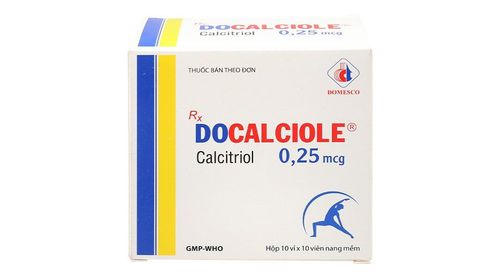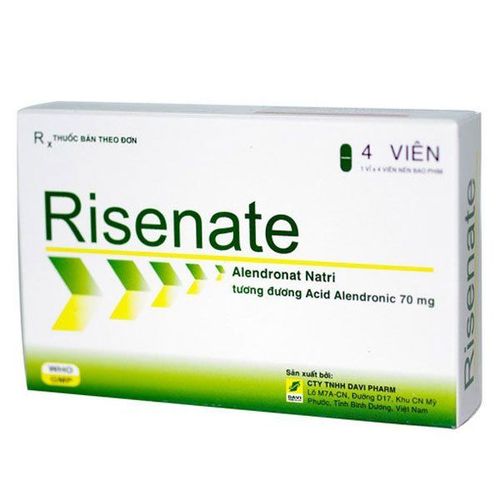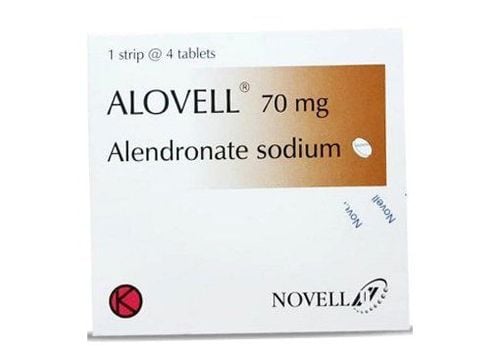This is an automatically translated article.
Alenroste 10 has the main ingredient alendronic acid, also known by the other common name Fosamax. This is a drug in the Bisphosphonate class, used in the treatment of osteoporosis and Paget's disease of the bones.
1. What are the effects of Alenroste 10?
Alenroste 10 has the main ingredient is Alendronate Sodium with a content of 10mg Alendronic acid, is indicated for use in the following cases:
Alenroste 10 is effective in preventing and treating postmenopausal osteoporosis in women gender. Used in the prevention of osteoporosis in cases at risk of developing osteoporosis after menopause, osteoporosis or in cases where the patient wants to maintain bone mass and reduce the risk of fracture. Treatment of osteoporosis in men. In combination with other drugs used in the prevention and treatment of corticosteroid-induced osteoporosis. Treatment of Paget's disease - is a fairly rare type of cancer that appears as psoriasis-like or eczema-like red patches on the nipple and areola. Mechanism of action:
Alendronate is a bisphosphonate, it can bind to hydroxyapatite crystals present in bone, reducing osteoclast-mediated bone resorption and reducing bone matrix breakdown. Both of these mechanisms contribute to the regulation of mineral reabsorption and turnover. Alendronate does not alter bone mineral accumulation in the endocardium or in the bone.
Contraindications:
The drug is not used in the treatment of osteoporosis caused by Crohn's; The drug is not used in the treatment of osteoporosis secondary to cystic fibrosis; The drug is not used in the treatment of fibrous dysplasia of the bone; Contraindicated to use alendronate in patients with hypersensitivity, esophageal problems, angina syndrome; Avoid the use of alendronate in patients with hypocalcaemia; Do not use the drug for patients with esophageal malformations; The person is unable to stand or sit upright for at least 30 minutes. Overdose and treatment:
Manifestations of drug overdose: Patients may have hypocalcemia, hypophosphataemia and affect the gastrointestinal tract with abdominal pain, nausea, vomiting. Treatment: Treat according to symptoms
2. Dosage and how to use Alenroste 10
How to use: The drug is prepared in the form of uncoated tablets and used orally. In order for the drug to have the best effect and be maximally absorbed into the body, the patient should take the drug with plenty of water at least 30 minutes before eating, should take the whole tablet. Absolutely patients should not drink with orange juice or carbonated drinks, containing caffeine because it will reduce the absorption of the drug.
Note: Patients should not take the medicine at bedtime or lie down immediately after taking the medicine so that the medicine enters the stomach faster and reduces the risk of esophageal irritation. You need to wait at least 30 minutes after taking the medicine before you should lie down.
Dosage:
Alendronate in oral tablet form 5mg, 10mg, 35mg, 40mg or 70mg; 70mg tablets for solution and 70mg/75ml oral solution.
Dosage for postmenopausal women: Apply a dosage of 5mg tablets orally once a day or 35mg tablets once a week. In the treatment of glucocorticoid-induced osteoporosis: 5 mg orally once daily or 10 mg once daily in women not on hormone replacement therapy. In the treatment of Paget's disease of bone: Apply oral dosage of 40mg/day for 6 months. For pediatric patients: Safety and efficacy have not been established. In case the elderly and people with kidney failure have creatinine ClCr concentration 35-60ml/min, there is no need to adjust the drug dosage. For people with severe kidney failure: Doctors do not recommend Alenroste 10 but need to find a more suitable alternative treatment.
3. Side effects of the drug Alenroste 10
In clinical studies, the majority of reactions that may occur during treatment with alendronate are usually not serious. When experiencing a mild reaction, the patient does not need to stop using the drug.
The most common undesirable effects include transient hypocalcaemia, transient hypophosphataemia, including: Abdominal pain, heartburn, nausea, constipation, diarrhea, flatulence and esophagitis, pain muscle pain, arthralgia, headache, dizziness, peripheral edema, back pain and asthenia.
Uncommon but reported adverse events include toxic epidermal necrolysis and oropharyngeal ulceration. Effects on the gastrointestinal tract with the most common symptom is ulceration and possible rupture of the esophagus, when this reaction occurs, the patient should be hospitalized and treated aggressively. Stomach and duodenal ulcers may also occur.
Other rare reactions such as osteonecrosis of the jaw are usually caused by tooth extraction or local infection; erosive esophagitis, esophagitis, esophageal ulcers and hypersensitivity reactions, Stevens-Johnson syndrome and toxic epidermal necrolysis, eye problems (uveitis or episcleritis).
4. Be careful when using Alenroste 10
The ingredient Alendronate is classified as a Category C drug for pregnancy (possibly risky drug class) according to the previous FDA classification system. Although it has not been confirmed whether the drug is excreted in breast milk, caution should be exercised because there are currently no studies on the safety and effectiveness of the drug during pregnancy. Patients taking parathyroid hormone medications should avoid taking alendronate. This combination may decrease serum calcium levels. There may be an increased risk of serious esophageal disease in patients who are unable to sit or stand upright for at least 30 minutes. Calcium levels and bone mineral density should be checked before starting treatment, and patients should be monitored for 6 to 12 months after treatment. Calcium should be supplemented at baseline and monitored continuously if there is a risk of recurrence of hypocalcaemia. Patients should reduce the dose or stop treatment if hypocalcaemia occurs during treatment.
5. Drug interactions
Due to other foods or drugs that contain a lot of calcium or aluminum (antacids) such as milk,... will reduce the absorption of Alendronate. Therefore, patients should be careful to use these products at least 30 minutes after taking Alendronate. Taking with vitamin D or highly active fluoride may increase the risk of side effects. When co-administered with intravenous Ranitidine will increase the concentration of Alendronate in the body. The combination of NSAIDs and Alendronate may increase the risk of stomach ulcers. Because both drugs have the potential to irritate the gastrointestinal mucosa. Aceclofenac, Acemetacin, Acetylsalicylic Acid: The risk or severity of adverse events may be increased when Aceclofenac is combined with the above medicines. Acipimox: The risk or severity of myopathy, rhabdomyolysis, and myoglobinuria may be increased when Alendronic acid is combined with Acipimox. Acyclovir: The risk or severity of nephrotoxicity and hypocalcemia may be increased when Acyclovir is combined with Alendronic acid. Aflibercept: The risk or severity of osteonecrosis and antiangiogenesis may be increased when Aflibercept is combined with Alendronic acid. Almasilate: The serum concentration of Alendronic acid may decrease when it is combined with Almasilate. Amikacin: The risk or severity of nephrotoxicity and hypocalcemia may be increased when Amikacin is combined with Alendronic acid. Amphotericin B: The risk or severity of nephrotoxicity and hypocalcemia may be increased when Amphotericin B is combined with alendronic acid. The basic information about Alendronic 10 in the above article is for reference only. Because Alendronic 10 is a prescription drug, patients should not use it on their own, but need to contact a specialist directly for a suitable prescription to ensure safety for health.













